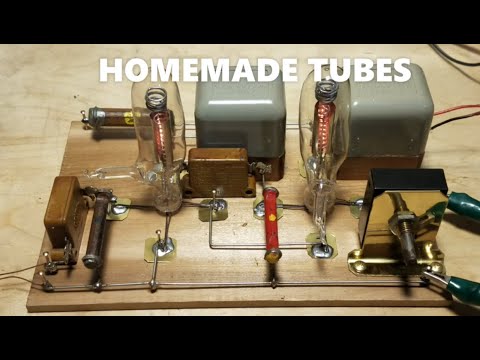This is seriously impressive, building a valve amp by first making your own valves!
When the Zombie Apocalypse happens, I want her in MY camp!
this was definitely one of the more interesting videos that I have seen. I am completely clueless as far valves are concerned, but ver interesting anyway…
I’m old enough that I had a elderly valve radio in my bedroom. I remember being excited when I got given a Transistor Radio for Christmas, I’d have been 4 or 5.
(the most basic of) Valves work pretty much like a transistor: You have a ‘Load’ input, common ground and a ‘Control’ gate, increasing the voltage on the Control allows the Load side to conduct more. There were lots of designs with multiple gates etc.
They also have a Heater circuit, and run hot. The radio in my room was huge! big wooden case. But like most valve radios it had a backlit frequency card and controls, the red glow of the valves doing the lighting.
In simple terms… for digital information, it started with relay driven logic, tubes (valves) was the next step to make for more of a programmable logic system along with a speed increase.
Then transistors, which became ttl when packaged as a gate, then cmos and lsi (large scale integration) …
The only thing that’s really changed is the physical size…
IMHO, just another way of looking at it…
![]()
Like a transistor? Not exactly. In normal circuits, a tube is controlled by voltage at the control grid. Negative voltage at the grid repels the electrons that are boiling off the cathode. The more negative the grid, the lower the cathode->plate current.
FETs are also controlled by voltage at the gate, and they are Field-Effect Transistors.
It doesn’t really matter whether it is voltage or current that is modulating transconductance or transresistance (depending on your point of view), ![]()
My understanding is that the FET was actually proposed before the BJT and is a closer analog to a normal tube than the BJT, but in both cases we call them transistors. So saying that a tube isn’t like a transistor because it is a bit more like a field-effect transistor than like a bipolar junction transistor feels like being over particular to me.
I was leaving out the details for simplicity… most of the fet types do use voltage to control current flow… that’s also more detail that doesn’t help in an overview.
They are all switches. The actual details of their operation isn’t what I was trying to convey.
A problem with cnc machine, I ask can your software talk to the machines controller… it matters not what os or hardware they have, if it talks we move on. If it doesn’t talk then more detail is required.
No one cares about the voltage levels on a usb or Ethernet cable.
It’s just a generalization of how our electronics have evolved… if you exclude the relay driven computers, I saw inside them all, at least up to the 80286 in the IBM AT…
I like details, but this wasn’t were I was trying to apply them… ![]()
![]()
I love this video. She gives enough detail that I could imagine doing it myself. WRT the details of tube functioning… I just recently got deeply into that. Sitting next to me is a Collins KWM-2 ham transceiver. Designed in the late 50’s, chock full of tubes. It had a problem with the transmit-receive switching. After transmitting, it would take a couple seconds to go back into receive. It turned out to be a leaky capacitor.
The impedance of that circuit was extremely high, and the capacitor tested good on my modern equipment. A weird and wonderful circuit, drawing on the physics of the device to work. Nowadays, such elegant analog design is not practiced; it’s much easier to just throw a few thousand transistors at the problem :).
In the 80s I was working as a tech for a navy contractor and was putting myself through school for an EE degree but after a year I already noticed the new boards were going more digital. I switched my major to CS. As you said, it’s easier to throw thousands of transistors at the problem and don’t forget, it takes far less to release a rev of software over a rev of hardware(if the hardware is sufficiently complex that is).
Loved the warm glow out the back of old radios back in the day. Probably why I also like nixie tube anything.
People still drive model-t’s and love it… they did the job…
Most people, even here, probably couldn’t tune a transceiver to it’s antenna load with knobs, without a trip to google… there is no reason to know that anymore…
It is much lower cost to make the complete ignition/fuel control via electronics than to physically make all the other components, points, coil, carburetor etc… along with a higher production rate and less failures…
Most people want to plug it in and use it… whatever is most simple with the least amount of work…
Simplified - ![]() -
-
![]()
What’s the fun in that? ![]()
